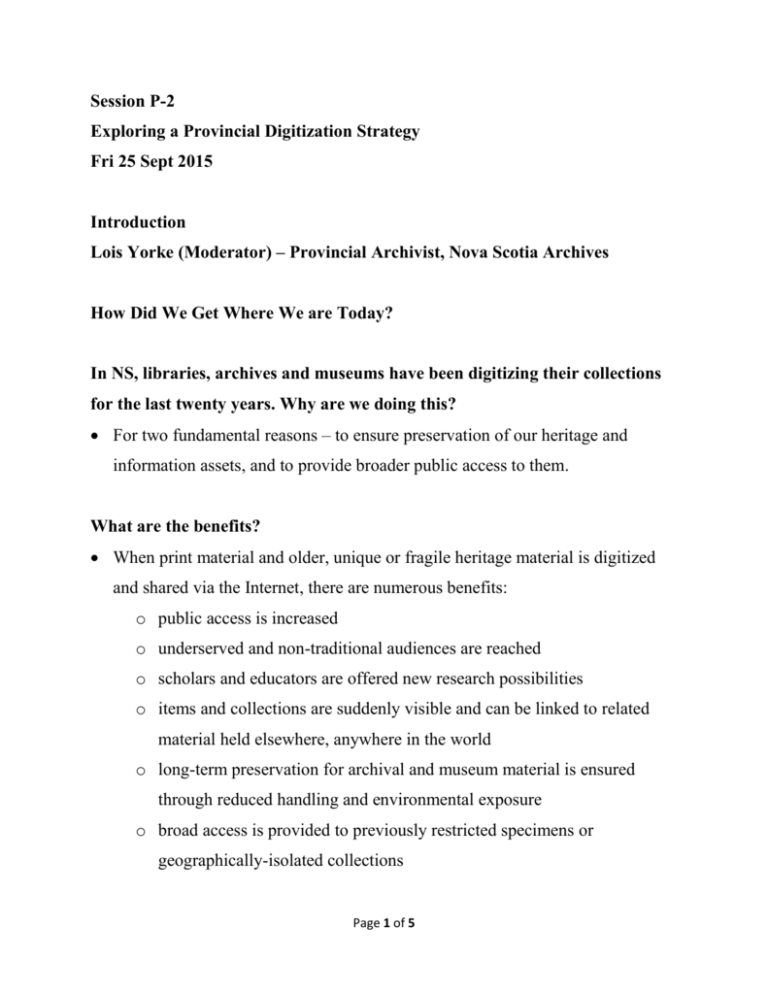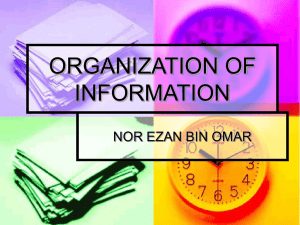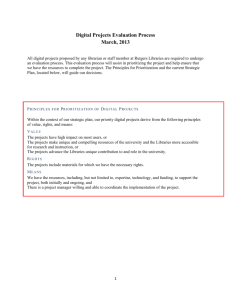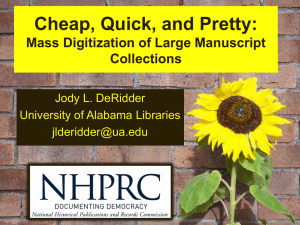Exploring a Provincial Digitization Strategy
advertisement

Session P-2 Exploring a Provincial Digitization Strategy Fri 25 Sept 2015 Introduction Lois Yorke (Moderator) – Provincial Archivist, Nova Scotia Archives How Did We Get Where We are Today? In NS, libraries, archives and museums have been digitizing their collections for the last twenty years. Why are we doing this? For two fundamental reasons – to ensure preservation of our heritage and information assets, and to provide broader public access to them. What are the benefits? When print material and older, unique or fragile heritage material is digitized and shared via the Internet, there are numerous benefits: o public access is increased o underserved and non-traditional audiences are reached o scholars and educators are offered new research possibilities o items and collections are suddenly visible and can be linked to related material held elsewhere, anywhere in the world o long-term preservation for archival and museum material is ensured through reduced handling and environmental exposure o broad access is provided to previously restricted specimens or geographically-isolated collections Page 1 of 5 o for library collections, digitization avoids expensive duplication, preserves older, rarer items, and ensures broad access via digital delivery What, specifically, have the three communities been doing over the last twenty years? Looking at libraries first…. Academic libraries and larger public libraries in NS are digitizing articles and chapters from print resources requested by patrons, and then providing the digital versions via desktop delivery Older libraries, including academic ones, often hold extensive and unique print collections which they are gradually digitizing, usually via special projects Smaller libraries, both academic and public, are undertaking limited digitization to meet the growing demand for access to local historical content Most libraries have access to needed equipment, but everyone is finding that: o demands are largely community-driven and are pushing the boundaries of collection development policies o libraries are frequently expected to be ‘the digital publisher of all locally produced materials’ o staff involvement is key to success in digitization o skills deficits and funding issues are barriers to efficiency Next, looking at archives and museums…. Both large and small, archives and museums in NS are gradually beginning to digitize ‘bits and pieces’ of their collections There are significant leaders in this, but both these communities have generally been slow to digitize, for various reasons: Page 2 of 5 o digitization has rarely been approached systematically; it remains projectbased, using short-term or one-time funding opportunities such as the current ‘Community Albums Initiative’; or it is driven by servicedelivery expectations such as ‘digitize-on-demand’ for researchers o many archives and museums are challenged by the size of their collections, and by the primary need for physical and intellectual control over them; establishing a strategy or priorities for digitization can be an added and overwhelming imposition on already limited resources o smaller archives and museums lack technical skills and website capacity to build and host digital content o digitization is especially challenging for 3D objects in museums – they’re difficult to digitize and require more financial outlay o digitization is expensive – it always requires more time, more money, and more human resources than first anticipated o digitization is also a swiftly-moving target – standards and best practices change routinely; expensive equipment becomes obsolete with every new operating system or software add-on; and lack of interoperability between electronic systems can quickly kill potential collaborative initiatives stone-dead in their tracks Reluctance to digitize is changing, however, as more museums and archives adopt increased access as a core institutional priority. Digitization then becomes key to meeting organizational goals and increasing relevance with the public. Clearly, if the three communities continue to move forward along the trajectories just described, digitization will remain haphazard and uneven; it will continue to be carried out in isolation; and when viewed across the broad spectrum of Nova Scotia’s libraries, archives and museums, it will perpetuate the old Digital Page 3 of 5 Divide – some of us will ‘do it’ and benefit, others won’t. The way ahead appears to lie in some sort of collaborative approach. If so, what steps are visible over the last twenty years? In the library community…. As one of its innovative library management services, Novanet provides digital delivery of print material to academic libraries in NS via its membership in the East Coast Relais Consortium created in 1999; a shared software solution enables digitization and delivery of material requested by members libraries In 2012, Novanet went a step further. With funding from the provincial government’s Excellence and Innovation Fund, a feasibility study was undertaken to explore centralized, long-term storage for duplicate and low-use print materials coming from participating libraries: o The proposal included a digitization centre with state-of-the-art equipment and software for digital delivery of items stored in the repository but requested back by member libraries; the centre would also provide services for special collections held by participating libraries. o The study, including a design phase, was completed in 2013, but the concept did not qualify for government assistance in the build phase o Novanet continues to explore the concept with other regional partners such as Libraries Nova Scotia, Parks Canada, CCH and AGNS – all of whom have vested interests in storage capacity and centralized services. Libraries Nova Scotia, established in 2007, promotes collaboration among the province’s libraries and cultural institutions. It has supported digitization partnerships done with leveraged funding, chiefly through the NS Historical Newspapers Project, launched in 2009 and now in its third phase; the project Page 4 of 5 has produced over thirty titles and 100,000 digital pages, across two centuries of ‘old newspapers’ stored in archives and public libraries throughout NS. Collaboration in the archives and museum communities…. Collaboration on digitization has tended to be internal to each discipline, rather than shared across, although this approach is changing MemoryNS, the new provincial online catalogue launched last fall, has 55 participating archives, and provides access to over 3500 holdings; 916 of them have digital objects attached. NovaMuse, the parallel provincial catalogue for the museum community, has 53 participants and contains 94,000 digital images NovaMuse has clearly set the benchmark for collaboration in building digital content for the museum community; moving forward, however, both the Council of NS Archives and the Association of NS Museums (owners of the respective catalogues) intend to build more digital content within their products, and see opportunities for aligning – perhaps even combining – MemoryNS and NovaMuse, given that the two systems appear technically compatible. So, where do we go from here? Moving forward, what do we want? A formal strategy doesn’t seem appropriate, with its structured commitments and deliverables, timelines, outputs, measurable, and implied funding support. Instead, a champion such as Libraries NS and partnerships with the professional associations and provincial institutions, combined with a strategic approach, guiding principles, and tools such as an asset map, are perhaps what’s needed at this time for the road ahead. Page 5 of 5






